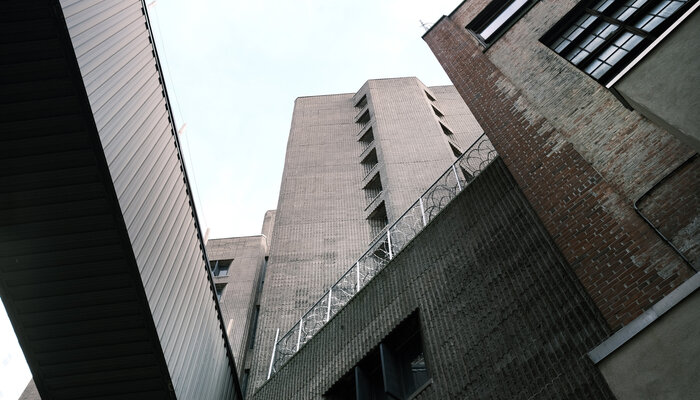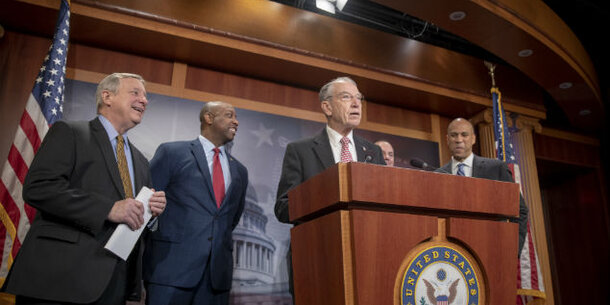The First Step Act is intended to do two things: cut unnecessarily long federal sentences and improve conditions in federal prison.
More than a year after it was enacted in 2018, key parts of the law are working as promised, restoring a modicum of fairness to federal sentencing and helping to reduce the country’s unconscionably large federal prison population. But other parts are not, demonstrating the need for continued advocacy and more congressional oversight. The way the Justice Department has been handling prisoner releases during the coronavirus pandemic gives some insight into what’s going wrong.
President Trump has bragged about signing the law, which was the first criminal justice reform bill passed in nearly a decade. But simply signing it is not enough. He needs to see it through.
Fixing a broken system
The First Step Act is the product of years of advocacy by people across the political spectrum. Indeed, a very similar bipartisan bill nearly passed in 2015, but was dragged down by election-year politics. The Trump administration began working on its own criminal justice bill in early 2018, and an initial deal was catalyzed by a core group of bipartisan legislators. It was then refined through a series of compromises and, once the Senate decided to pick up the bill, sailed through both houses of Congress with supermajority support.
The law we now know as the First Step Act accomplishes two discrete things, both aimed at making the federal justice system fairer and more focused on rehabilitation.
Its sentencing reform components shorten federal prison sentences and give people additional chances to avoid mandatory minimum penalties by expanding a “safety valve” that allows a judge to impose a sentence lower than the statutory minimum in some cases. These parts of the First Step Act are almost automatic: once the act was signed, judges immediately began sentencing people to shorter prison terms in cases came before them. Similarly, people in federal prison for pre-2010 crack cocaine offenses immediately became eligible to apply for resentencing to a shorter prison term.
The law’s prison reform elements are designed to improve conditions in federal prison in two ways. One is by curbing inhumane practices, such as eliminating the use of restraints on pregnant women and encouraging placing people in prisons that are closer to their families. The other is by reorienting prisons around rehabilitation rather than punishment. That is no small task. Successfully expanding rehabilitative programming in federal prison will require significant follow-through from Congress and the Department of Justice. It’s no surprise, then, that these distinct parts of the act are functioning differently.
Relief from harsh sentences
First, the good news. The First Step Act’s sentencing reforms are off to a strong start.
Before 2010, an offense involving 5 grams of crack cocaine, a form of the drug more common in the Black community, was punished as severely as one involving 500 grams of powder. The Fair Sentencing Act of 2010 changed that, reducing this 100:1 disparity to 18:1 — but only on a forward-going basis. People convicted under the now-outdated crack laws were stuck serving the very sentences that Congress had just repudiated.
The First Step Act fixed that by making the Fair Sentencing Act retroactive. According to the Justice Department, as of May, roughly 3,000 people serving outdated sentences for crack cocaine crimes had already been resentenced to shorter prison terms. Shortened or bypassed mandatory minimums mean that every year another estimated 2,000 people will receive prison sentences 20 percent shorter than they would have.
Another 3,100 people were released in July 2019, anywhere from a few days to a few months early, when the First Step Act’s “good time credit fix” went into effect. This simple change allowed people in federal prison to earn approximately an extra week off their sentence per year — and it applied retroactively, too. For some people it meant seeing their friends and family months earlier than expected.
Taken together, these changes represent an important decrease in incarceration. One year after the First Step Act was signed, the federal prison population was around 5,000 people smaller, continuing several years of declines. It has continued to shrink amidst the coronavirus pandemic.
To be sure, there’s still a long way to go: the federal prison population remains sky-high. And the Department of Justice does not appear to be in complete lockstep with the White House’s celebration of the law. In some old crack cocaine cases, federal prosecutors are opposing resentencing motions or seeking to reincarcerate people who have just been released. Prosecutors in these cases argue that any motions for resentencing must also consider the (often higher) amount of the drug the applicant possessed according to presentence reports. Other technical disputes are also cropping up, with the Department of Justice often arguing for a narrow interpretation of the First Step Act.
Toward a better prison system
When it comes to improving programming within federal prison, even more work remains to be done. Federal prisons offer some opportunities for people in prison to participate in services that either address their individual needs, or help prepare them for life after release. Drug treatment and drug education are two examples; others include ESL and educational classes.
The First Step Act calls for the Bureau of Prisons to significantly expand these opportunities. Within a few years, the BOP must have “evidence-based recidivism reduction programs and productive activities” available for all people in prison. That means vocational training, educational classes, and behavioral therapy (to name a few options recommended in the act) should be staffed and broadly available. Participating in these programs will in turn enable imprisoned people to earn “time credits” that they can put toward a transfer to prerelease custody — that is, a halfway house or even home confinement — theoretically allowing them to finish their sentence outside of a prison.
Rolling out this system as intended will be a challenge, however, in part because BOP programs are already understaffed and underfunded. Around 25 percent of people spending more than a year in federal prison have completed zero programs. A recent BOP budget document described a lengthy waiting list for basic literacy programs. And according to the Federal Defenders of New York, the true extent of the BOP’s programming shortfall isn’t even known, because the BOP won’t share information on programming availability or capacity. The bureau offered little insight into its existing capacity and needs at a pair of congressional oversight hearings last fall. Worse, a recent report from the First Step Act’s Independent Review Committee, made up of outside experts to advise and assist the government with implementing the law, casts doubt on the quality of the BOP’s existing programming.
The BOP’s lack of transparency also makes it hard to know how “time credits” are being awarded — and thus, whether the BOP is permitting people to make progress toward prerelease custody as Congress intended. The First Step Act provides that most imprisoned people may earn 10 to 15 days of “time credits” for every 30 days of “successful participation” in recidivism-reduction programming. But a recent report suggests the BOP will award a specific number of “hours” for each program. How many “hours” make up a “day,” for the purpose of awarding credits? This highly technical issue may appear trivial, but could significantly affect the reach of the First Step Act.
People with inside knowledge of the system point to other concerns, too. The law excludes some imprisoned people from earning credits based on the crime that led to their incarceration or their role in the offense, and some advocates report that the BOP has applied those exclusions broadly, disqualifying a much larger part of the imprisoned population than Congress intended. Advocates also have heard that program availability in prisons is much spottier than the BOP has suggested, rendering illusory the DOJ’s claim that people are already being assigned to programs and “productive activities” tailored to their needs.
While some progress is being made, all of these concerns point to a need for more congressional oversight — narrowly focused on the availability and capacity of “recidivism reduction” programming in the BOP.
Funding Insecurity
Any expansion of programming also won’t be free. Knowing that, the First Step Act authorized $75 million per year for five years for implementation. But authorization is only the beginning of the budgeting process. Congress must also formally appropriate money to the BOP to fund the First Step Act for each year that it is authorized.
Thankfully, in December 2019, Congress passed and the president signed the Consolidated Appropriations Act, which included full funding for the First Step Act through the end of the current fiscal year. That makes up for a bumpy start: last year, Congress failed to appropriate anything at all, forcing the DOJ to use $75 million from elsewhere in its budget to cover the temporary shortfall.
While this new funding is good news, it still might not be enough. According to a member of the Independent Review Committee, full implementation may cost closer to $300 million. After factoring in “training, staffing, [and] building things like classrooms,” he says, $75 million simply may not be enough. But any more substantial funding seems unlikely to materialize: in a recent budget, the White House sought nearly $300 million to fund improvements related to the law, of which only $23 million was earmarked for programming.
Undervaluing rehabilitation and entrenching bias
In late March, the Justice Department appeared to finally acknowledge the need to transfer people in federal prison to home confinement to keep them safe from the coronavirus. But transfers have been slow, and a recent report from ProPublica shows one reason why.
The DOJ prioritized transfers for people deemed to pose a “minimum” risk of recidivism under a new system developed for the First Step Act. But that system, called “PATTERN,” has never been perfect, and appears to have been quietly revised to make it more difficult to reach a “minimum” score — and by extension, that much harder to win a transfer to home confinement. This revelation offers the latest example of how the First Step Act’s implementation has proceeded in fits and starts.
Before imprisoned people can use “time credits” they’ve earned from prison programming, two conditions must be met. First, if they’re seeking a transfer to a halfway house, there must be a bed available. That’s not a sure thing, especially after a round of budget cuts by the Trump administration. Second, an incarcerated person must demonstrate that their risk of committing a new crime is low, as calculated by PATTERN.
The process of developing that tool has not gone smoothly. The first version unveiled by the DOJ, in July 2019, appeared to use a method for calculating “risk” that overstated the actual risk of re-offending among formerly incarcerated people, exaggerated racial disparities, and gave people only marginal credit for completing education, counseling, and other programs while in prison. Taken together, the tool gave short shrift to the idea that people can change while in prison — the very premise of the First Step Act.
Early this year, the DOJ shared what seemed like good news: PATTERN, it said, had been improved to partially address some of the concerns raised by the Brennan Center and others. But the tool continued to use an overly broad definition of recidivism. And while the DOJ claimed it introduced changes to reduce racial disparities, it did not release data on the revised tool’s actual effect on racial disparities. As a result, imprisoned people, families, lawyers, and advocates were all concerned when the DOJ announced it would use PATTERN to help determine who would be transferred out of federal prison during the pandemic.
Those concerns were justified. It now seems that the BOP changed PATTERN more significantly than they initially disclosed to make it much harder to qualify as a “low” or “minimum” risk. (A DOJ report, released a week after ProPublica’s story, suggests that the impact of these changes was relatively small, but offers limited data, and — still — provides no analysis of racial disparities.) This change will certainly narrow the effect of the First Step Act. But more urgently, it seems likely to keep more people in federal prison, exposed to a heightened risk of catching a deadly disease.
It’s tempting to write off these technical implementation issues, but they carry real consequences for imprisoned people and their families.
Trump has repeatedly claimed credit for passing the First Step Act. He did the same in a Super Bowl ad. Now his administration needs to do the hard work of ensuring that the law lives up to its promise.






